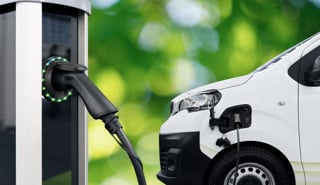
Fleet FAQ
Q:
How to implement a workplace charging scheme?
A:
Employers who install workplace charge points for electric vehicles (EVs) soon find utilisation rates exceeding expectations, according to a spokesman for Pod Point.
With commuting emissions counting towards businesses’ Scope 3 greenhouse gas emissions, there are compelling corporate social responsibility reasons for companies to invest in workplace chargers as well as positive HR benefits.
The investment in workplace charging can be significant, so it pays to plan ahead in order to future-proof the infrastructure.
Key questions fleet managers should address include:
How many chargers will be required?
This is a decision based on many factors including the number of electric cars operated, the types of chargers required, the number of available parking bays and the available budget for the installations.
What speed of charger should be installed?
Faster isn’t always better – or necessary – for organisations.
Typically, a 7kW charge point will provide an EV with up to five miles of charge in 10 minutes. An ultra-fast 150kW unit gives up to 100 miles in the same time.
The costs of buying and installing charge points varies massively: a 7kW charge point capable of charging two vehicles at the same time can cost from £4,000 for an organisation to install, while a 150kW unit is upwards of £100,000.
As well as cost and the electricity capacity of the site – if demand exceeds supply, a substation may need to be installed at significant expense – organisations need to consider the dwell time of its EVs, i.e. how long they are parked up for, as the speed of charger is governed by this.
A key factor is to understand the power capacity and constraints at the site, given that any upgrade to the local grid in order to increase power supply can be prohibitively expensive.
The available electricity dictates the number and speed of chargers that it’s possible to install.
“For example, if a site has a 100 amp, three-phase supply, that would be enough to support one 50kW DC charger, three 22kW chargers, or 27 7kW chargers with load management (which manages the power available to each charger dependent on how many vehicles are plugged in at any one time),” says the spokesman.
Cars that are parked all day, or vans parked at a depot overnight, can have a meaningful charge from a 7kW charger, whereas a hard-working van fleet might want to invest in higher cost, fast chargers because of the productivity gains available through minimising charging downtime.
Will users have to pay for the electricity they use and, if so, how much?
Employers must decide whether to charge staff for plugging in their cars at work and, while early adopters have tended to offer the facility for free, the spokesman cautions businesses that HMRC has made it clear that the benefit is zero rated; in effect, acknowledging that it is a benefit, and therefore one for which employers are likely to need to account for or, perhaps, charge for in future.
Electricity is not classed as a vehicle fuel by HMRC, so there are no benefit-in-kind (BIK) tax implications if an organisation wishes to provide free charging to employees.
Many do currently offer free charging as a perk to staff, while it can also be used as an incentive to increase EV uptake among workers.
Typical charging schemes include billing for either the amount of electricity used or the length of time a vehicle has been plugged in.
This gives drivers an incentive to unplug their vehicle when they have enough charge rather than blocking the charge point and preventing other EV drivers from using it.
Charge points can be operated by staff RFID (radio-frequency identification) cards, apps, or contactless cards provided by the company which installs and manages the units.
If drivers have to pay for using workplace charge points, they can claim for business mileage from their employee with the Government setting its advisory electricity rate (AER) at 5 pence per mile (ppm).
Something else to consider is who will have access to the charge points – fleet drivers, all employees, visitors, general public?
Who will be responsible for maintaining the chargers?
Charge points are not indestructible, meaning businesses need to consider a maintenance contract to keep chargers operational.
At the outset, organisations need to consider whether they will take on the management of the charge points once they are installed, or whether they use a charge point provider to supply this service.
Using a charge point supplier which also has a public charging network – such as BP Chargemaster and Engie – may mean the workplace set-up can be integrated with their public infrastructure so all charging can be included on one monthly bill.
Who is using the workplace charge points, when and for how long can be managed through groups on media channels such as WhatsApp or MS Teams.
Can you install charge points on leased sites?
An obstacle faced by many organisations is they lease the site of their workplace, meaning they need permission from their landlord before installing charge points.
What Government support is available?
Under the Government’s Workplace Charging Scheme (WCS), organisations can receive grants towards the upfront cost of the purchase and installation of charge points.
The contribution is limited to 75% – or £350 per socket – of these costs, up to a maximum of 40 sockets per company. These can be on different sites.
If, for example, an organisation applied for support for 10 sockets initially, it would later be able to apply for further vouchers for funding provided the total applied for does not exceed 40.
However, all installations included on a single voucher must be the subject of a single claim: once a voucher has been redeemed it cannot be re-used even if the number of sockets installed is fewer than that specified on the voucher.
Where should the charge points be located?
A key factor is where the site’s power supply is located. The closer charge points are, the less digging needs to be carried out and the lower the cost of the install.
One of the first steps is to ensure that any civil engineering work, such as digging trenches and laying cables, is only done once, even if its potential capacity far exceeds the initial number of chargers to be installed.
“With civils functions, maximise your provision from day one. You can install sub-surface ducting even if you don’t use it the first time around. It’s still much cheaper than retrenching your car park,” says the spokesman.
*Financial information accurate as of 2022
> Interested in comparing electric vehicle data? Check out our EV tool.
> Interested in ensuring the efficient use of EVs. Check out our dedicated editorial sections: Insight & policy | EV news | Charging & infrastructure | Costs & incentives | Benefit-in-kind | EV case studies | EV road tests
> EVs by price: lowest to highest

















